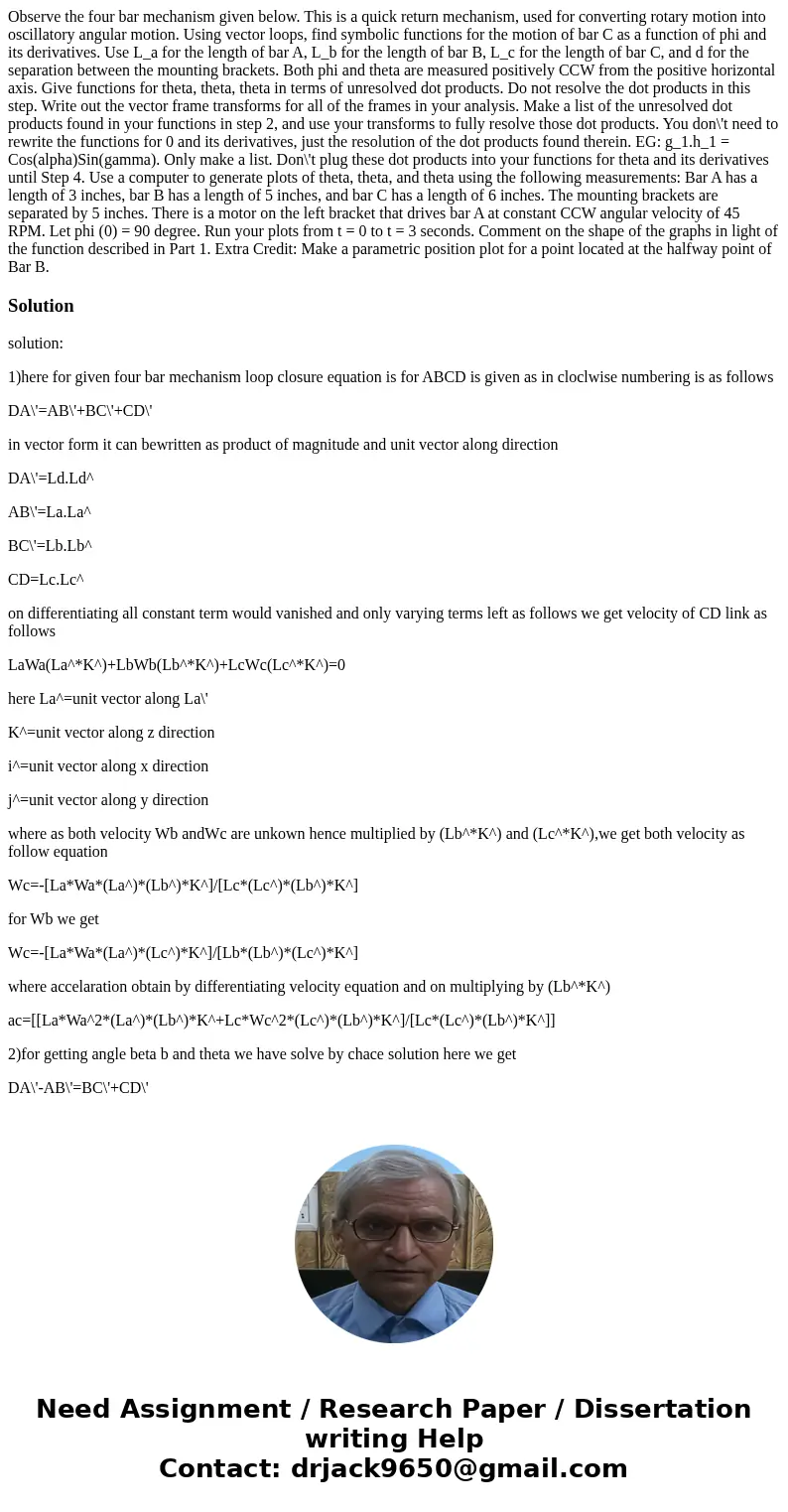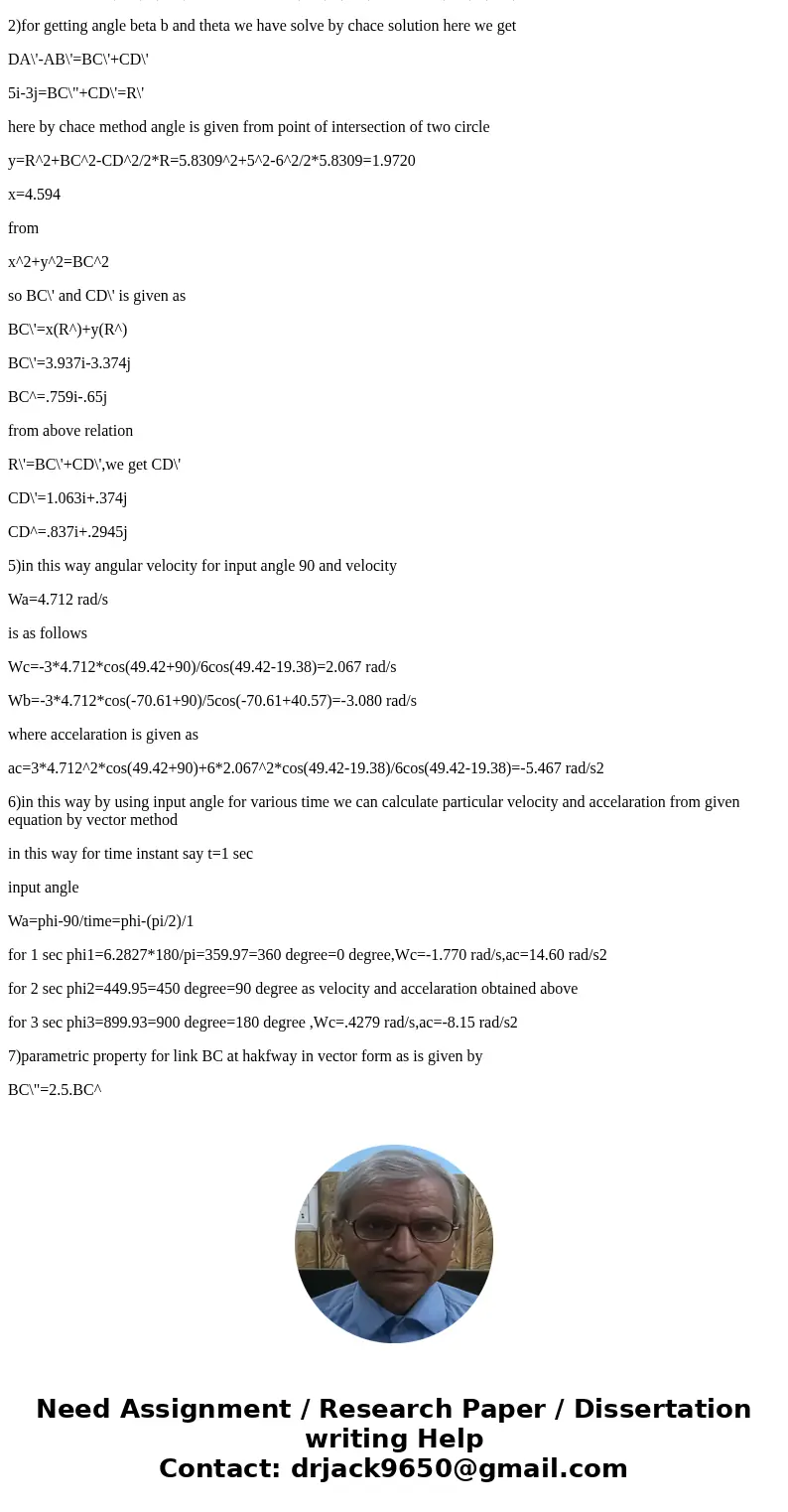Observe the four bar mechanism given below This is a quick r
Solution
solution:
1)here for given four bar mechanism loop closure equation is for ABCD is given as in cloclwise numbering is as follows
DA\'=AB\'+BC\'+CD\'
in vector form it can bewritten as product of magnitude and unit vector along direction
DA\'=Ld.Ld^
AB\'=La.La^
BC\'=Lb.Lb^
CD=Lc.Lc^
on differentiating all constant term would vanished and only varying terms left as follows we get velocity of CD link as follows
LaWa(La^*K^)+LbWb(Lb^*K^)+LcWc(Lc^*K^)=0
here La^=unit vector along La\'
K^=unit vector along z direction
i^=unit vector along x direction
j^=unit vector along y direction
where as both velocity Wb andWc are unkown hence multiplied by (Lb^*K^) and (Lc^*K^),we get both velocity as follow equation
Wc=-[La*Wa*(La^)*(Lb^)*K^]/[Lc*(Lc^)*(Lb^)*K^]
for Wb we get
Wc=-[La*Wa*(La^)*(Lc^)*K^]/[Lb*(Lb^)*(Lc^)*K^]
where accelaration obtain by differentiating velocity equation and on multiplying by (Lb^*K^)
ac=[[La*Wa^2*(La^)*(Lb^)*K^+Lc*Wc^2*(Lc^)*(Lb^)*K^]/[Lc*(Lc^)*(Lb^)*K^]]
2)for getting angle beta b and theta we have solve by chace solution here we get
DA\'-AB\'=BC\'+CD\'
5i-3j=BC\"+CD\'=R\'
here by chace method angle is given from point of intersection of two circle
y=R^2+BC^2-CD^2/2*R=5.8309^2+5^2-6^2/2*5.8309=1.9720
x=4.594
from
x^2+y^2=BC^2
so BC\' and CD\' is given as
BC\'=x(R^)+y(R^)
BC\'=3.937i-3.374j
BC^=.759i-.65j
from above relation
R\'=BC\'+CD\',we get CD\'
CD\'=1.063i+.374j
CD^=.837i+.2945j
5)in this way angular velocity for input angle 90 and velocity
Wa=4.712 rad/s
is as follows
Wc=-3*4.712*cos(49.42+90)/6cos(49.42-19.38)=2.067 rad/s
Wb=-3*4.712*cos(-70.61+90)/5cos(-70.61+40.57)=-3.080 rad/s
where accelaration is given as
ac=3*4.712^2*cos(49.42+90)+6*2.067^2*cos(49.42-19.38)/6cos(49.42-19.38)=-5.467 rad/s2
6)in this way by using input angle for various time we can calculate particular velocity and accelaration from given equation by vector method
in this way for time instant say t=1 sec
input angle
Wa=phi-90/time=phi-(pi/2)/1
for 1 sec phi1=6.2827*180/pi=359.97=360 degree=0 degree,Wc=-1.770 rad/s,ac=14.60 rad/s2
for 2 sec phi2=449.95=450 degree=90 degree as velocity and accelaration obtained above
for 3 sec phi3=899.93=900 degree=180 degree ,Wc=.4279 rad/s,ac=-8.15 rad/s2
7)parametric property for link BC at hakfway in vector form as is given by
BC\"=2.5.BC^


 Homework Sourse
Homework Sourse